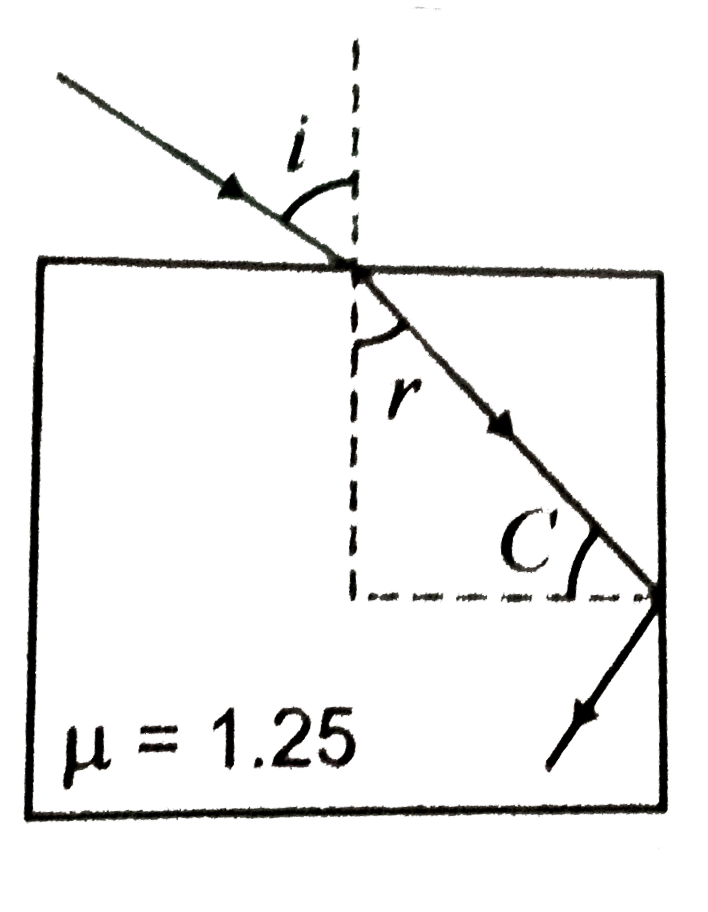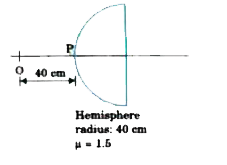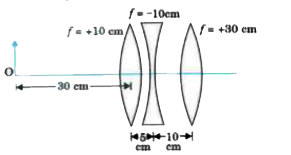SOLVED EXAMPLES from MODERN PUBLISHERS PHYSICS Chapter 104 RAY OPTICS AND OPTICAL INSTRUMENTS for Class 12
| Class 12 | PHYSICS |
| Chapter | RAY OPTICS AND OPTICAL INSTRUMENTS |
| MODERN PUBLISHERS PHYSICS | SOLVED EXAMPLES |
| Medium | English |
| Academic Year | 2023-2024 |
Question 1
An object is kept in front of a spherical mirror and it is found that the image of height double to that of the object is formed by the mirror. If radius of curvature of spherical mirror is 40 cm then what are the possible positions of object in front of the mirror and which type of mirror is this?View SolutionQuestion 7
a concave mirror of focal length 20cm and a convex mirror of focal length 15cm are placed 50cm apart, such that the two mirrors face eaachother. An object is placed exactly midway between them. Fing the nature and position of image formed by reflection first at concave mirror and then at convex mirror. View SolutionQuestion 15
At the bottom of a trough filled with water a rectangular glass slab is placed. A ray of light is incident on the water surface at an angle of 30∘ and enters the glass after passing through the water. What is the angle of refraction in glass? Given, refractive index of water is 1.33 and that of glass is 1.5.View SolutionQuestion 19
To determine the refractive index of a liquid experimentally, a mark is made on the beaker and a microscope was focussed on it, giving a reading of 3.42 cm. On pouring liquid till a height 2.68 cm inside the beaker, the reading of refocussed microscope is 3.38 cm. Calculate the refractive index of the liquid.View SolutionQuestion 28
A point source of monochromatic light 'S' is kept at the centre of the bottom of a cylinder of radius 15.0cm. The cylinder contains water (refractive index 4//3) to a height of 7.0cm. Draw the ray diagram and calculate the area of water surface through which the light emerges in air.View SolutionQuestion 33
A ray of light is incident at an angle of 60∘ on the face of a prism having refracting angle 30∘. The ray emerging out of the prism makes an angle 30∘ with the incident ray. Show that the emergent ray is perpendicular to the face through which it emerges and calculate the refractive index of the material of prism.View SolutionQuestion 42
A curved surface of μ=1.5 forms a virtual image of an object which is placed in air at a distance of 15 cm from the surface. The image is formed at a distance of 60 cm, what is the radius of curvature of the curved surface? Also, calculate the power of curved surface and the two focal lengths of the surface.View SolutionQuestion 61
A convex lens is placed at a distance of 40 cm from a screen. A point source is placed at a distance of 60 cm from the screen on the same side of the lens. At this position of point-source, a circular spot of light of diameter equal to the lens is formed. Show the formation of image by a ray diagram. Up to what distance the source be displaced so that its clear image can be formed on the screen?View SolutionQuestion 70
Two coaxial thin lenses are placed in contact with each other and a small object is placed at a distance of 20cm from the combination of lenses. The focal length of each lens is 30 cm. What will be the distance between the object and the image when both the lenses are (i) convex (ii) concaveView SolutionQuestion 72
An equiconvex lens with radii of curvature of magnitude R each is put over a liquid layer poured on top of a plane mirror. A small needle, with its tip on the principal axis of the lens, is moved along the axis until its inverted real image coincides with the needle itself. The distance of the needle from the lens is measured to be 'a'. On removing the liquid layer and repeating the experiment the distance is found to be 'b'.
Given that the two values of distances measured represent the focal length values in the two cases, obtain a formula for the refractive index of the liquid.
 View Solution
View SolutionQuestion 73
A convex lens is placed over a plane mirror. A pin is now positioned so that there is no parallax between the pin and its image formed by this lens-mirror combination. How can this observation be used to find the focal length of the convex lens? Give appropriate reasons in support of your answer. View SolutionQuestion 83
A man with normal near point (25 cm) reads a book with small print using a magnifying glass : a thin convex lens of focal length 5cm.
(a) What are the closest and the farthest distances at which he can read the book when viewing through the magnifying glass ?
(b) What is the maximum and the minimum angular magnifications (magnifying powers) possible using the above simple microscope ?View SolutionQuestion 84
A figure divided into squares, each of size 1 mm2, is being viewed at a distance of 9 cm through a magnifying lens of focal length 10 cm, held close to the eye.
(i) Draw a ray diagram showing the formation of the image.
(ii) What is the magnification produced by the lens? How much is the area of each square in the virtual image?
(iii) What is the angular magnification of the lens?View Solution
All Exercises from MODERN PUBLISHERS PHYSICS Class 12 PHYSICS RAY OPTICS AND OPTICAL INSTRUMENTS
- CHAPTER PRACTICE TEST
- Conceptual Questions
- Higher Order Thinking Skills & Advanced Level (QUESTIONS WITH ANSWERS)
- NCERT (EXemplar Problems Obejective Questions) (Multiple Choice Questions (Type-I)
- NCERT (EXemplar Problems Obejective Questions) (Multiple Choice Questions (Type-II)
- NCERT (Exemplar Problems Subjective Questions) (Very Short Answer Type Questions)
- NCERT FILE SOLVED (TEXT BOOK EXERCISES)
- OBJECTIVE TYPE QUESTIONS (A. MULTIPLE CHOICE QUESTIONS)
- OBJECTIVE TYPE QUESTIONS (ASSERTION REASON TYPE QUESTIONS)
- OBJECTIVE TYPE QUESTIONS (B. MULTIPLE CHOICE QUESTIONS)
- OBJECTIVE TYPE QUESTIONS (C. MULTIPLE CHOICE QUESTIONS)
- OBJECTIVE TYPE QUESTIONS (D. MULTIPLE CHOICE QUESTIONS)
- OBJECTIVE TYPE QUESTIONS (INTEGER TYPE QUESTIONS)
- OBJECTIVE TYPE QUESTIONS (JEE (ADVANCED) FOR IIT ENTRANCE)
- OBJECTIVE TYPE QUESTIONS (JEE (MAIN) & OTHER STATE BOARDS FOR ENGINEERING ENTRANCE)
- OBJECTIVE TYPE QUESTIONS (MATCHING TYPE QUESTIONS)
- OBJECTIVE TYPE QUESTIONS (MATRIX MATCH TYPE QUESTIONS)
- PRACTICE PROBLEMS (1)
- PRACTICE PROBLEMS (10)
- PRACTICE PROBLEMS (11)
- PRACTICE PROBLEMS (2)
- PRACTICE PROBLEMS (3)
- PRACTICE PROBLEMS (4)
- PRACTICE PROBLEMS (5)
- PRACTICE PROBLEMS (6)
- PRACTICE PROBLEMS (7)
- PRACTICE PROBLEMS (8)
- PRACTICE PROBLEMS (9)
- Revision Exercises (Additional Questions)
- Revision Exercises (Fill in the Blanks)
- Revision Exercises (Long Answer Questions)
- Revision Exercises (Numerical Problems)
- Revision Exercises (Short Answer Questions)
- Revision Exercises (Very Short Answer Questions)
- SOLVED EXAMPLES
- Tough & Tricky (PROBLEMS)


 .
.



 .
.




